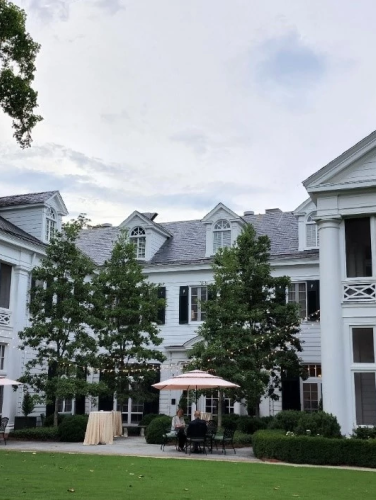
Duke Mansion
(ca. 1915)
The founder of the American Tobacco Company and an original investor in what became Duke Energy purchased the Duke Mansion to share his North Carolina upbringing with his only child.
400 Hermitage Rd, Charlotte, NC 28207
The Colonial Revival house known as the Duke Mansion was originally constructed by Zebulon Vance Taylor (1868-1921), president of the Southern Public Utilities Company, and his wife Irvin Scales Taylor (1872-1920) on several parcels of land in the prestigious Myers Park suburb. The noted industrialist and philanthropist James Buchanan Duke (1856-1925) purchased the house and property in 1919. He then assembled twelve more adjoining parcels to form a 15+ acre estate and tripled the already substantial house into a majestic mansion of 45 rooms and 12 baths between 1919 and 1922. This was the only house Duke owned in North Carolina during the years of his greatest power and influence. He called it Lynnwood. His primary residence was a 2,600-acre estate in Somerville, New Jersey.
Property Quick Links
In 1904, fourteen years after founding his American Tobacco Company, Duke met Dr. Walker Gill Wylie (1849-1923), a New York physician who had joined with his brother in 1899 to launch the Catawba Power Company of Fort Mill, South Carolina, the first hydroelectric production venture on the Catawba River. Duke partnered with the financially strapped Wylie Brothers to provide capital for expansion, forming the Southern Power Company. Duke believed that North Carolina’s economy would only achieve its potential if sufficient power was available to sustain textile manufacturing. By harnessing the Catawba River, the new company allowed the textile industry to prosper in the Piedmont.
In 1907, Duke married Nanaline Holt Inman (1869-1962). Duke’s only child, Doris (1912-1993), was born to that union. Duke wanted his daughter to experience the region in which he had spent his boyhood and young adulthood, prompting him to acquire and develop Lynnwood so that he could bring his family to Charlotte for extended visits, especially in the winter. But Nanaline found Charlotte less than exciting, typically returning to New Jersey long before her husband and daughter. In December 1924, a series of meetings in the west wing of the house culminated in the establishment of the Duke Endowment, a philanthropic enterprise of enormous importance to the people of the Carolinas.
James Duke died at his Somerville home in 1925. His widow sold Lynnwood and most of its contents in 1926 to Charles C. Coddington (1878-1928), owner of the WBT radio station and a local automobile dealership. The property was later acquired by Martin Luther and Ohla Brown Cannon (1885-1952 and 1887-1966, respectively) in 1929. In 1950, the Cannons gave the property to Myers Park Presbyterian Church. Over time, the estate was subdivided and sold as individual lots. In 1996, the nonprofit Lynnwood Foundation was established to preserve Duke Mansion. By 1998, the estate had become an historic inn and meeting center as well as the home of the Lee Institute, an organization that focuses on civic leadership, innovation, and collaboration.

